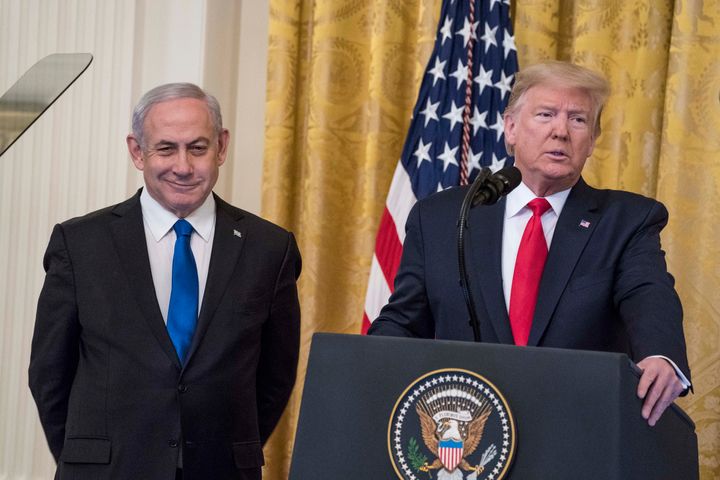US president Donald Trump has unveiled his long-awaited Middle East peace plan, calling for the creation of a State of Palestine with its capital in portions of east Jerusalem.
He declared it a “win-win” opportunity for both Israel and the Palestinians.
The plan ends speculation as to whether his administration, in preparing a proposal without input from Palestinian leaders, would abandon a “two-state resolution” to the conflict.
Trump, releasing the plan before a pro-Israel audience at the White House with Israeli prime minister Benjamin Netanyahu by his side, acknowledged that he has done a lot for Israel, but he said he wanted the deal to be a “great deal for the Palestinians”.
Trump said the deal is a “historic opportunity” for Palestinians to achieve an independent state of their own.
The plan more than doubles the territory currently under Palestinian control, although it also recognises Israeli sovereignty over major settlement blocs in the West Bank.
The Palestinians have already rejected the proposal, accusing Trump of being biased in favour of Israel as he has adopted policies that bolster Israel at their expense.

The plan does call for a four-year freeze in new Israeli settlement construction, during which time details of a comprehensive agreement would be negotiated.
However, it was not immediately clear if the freeze could be extended if a final deal is not concluded in the four years.
The 50-page political outline goes further in concessions to the Palestinians than many analysts had believed was likely.
However, it would require them to accept conditions they have been previously unwilling to consider, such as accepting West Bank settlements.
It builds on a 30-page economic plan for the West Bank and Gaza that was unveiled last June and which the Palestinians have also rejected.
Under the terms of the “peace vision” that Trump’s son-in-law and senior adviser Jared Kushner has been working on for nearly three years, the future Palestinian state would consist of the West Bank and Gaza, connected by a combination of above-ground roads and tunnels, according to the officials.
Officials said that both Israeli prime minister Benjamin Netanyahu and his main political challenger in March elections, Benny Gantz, had signed off on the plan.
Netanyahu was beside Trump as he unveiled the plan at the White House.
The event cames as Trump’s impeachment trial continues in the Senate and Israel’s parliament had planned a hearing to discuss Mr Netanyahu’s request for immunity from criminal corruption charges.
Netanyahu withdrew that request hours before the proceedings were to begin, but Israel’s parliament, the Knesset, is still expected to meet.
The body had been likely to vote against immunity, dealing Netanyahu a blow.
In the run-up to the March 2 election, Netanyahu has called for annexing parts of the West Bank and imposing Israeli sovereignty on all its settlements there.
Israel captured the West Bank in the 1967 war, and the Jordan Valley in particular is considered a vital security asset.
Security responsibility for the Jordan Valley would remain in Israel’s hands for the foreseeable future but could be scaled back as the nascent Palestinian state builds its capacity, under the terms of the plan, which says that statehood will be contingent on the Palestinians meeting international governance criteria.
US officials said they expected negative responses from the Palestinians, as well as Turkey and Iran, but were hopeful that Jordan and Egypt, the only two Arab nations to have peace treaties with Israel, would not reject it outright.
The officials said they expected Gulf Arab states like Saudi Arabia, the United Arab Emirates and others to cautiously welcome the plan.
The reaction of Jordan, which would retain its responsibilities over Jerusalem’s al-Aqsa Mosque under the plan, will be particularly significant, according to the officials, who said Kushner and others were reaching out to Arab leaders ahead of the rollout.
The Palestinians see the West Bank as the heartland of a future independent state and east Jerusalem as their capital.
Most of the international community supports their position, but Trump has reversed decades of US foreign policy by siding more blatantly with Israel.
The centrepiece of his strategy was recognising Jerusalem as Israel’s capital and moving the American Embassy there.
He has also closed Palestinian diplomatic offices in Washington and cut funding to Palestinian aid programmes.
Those policies have proven popular among Trump’s evangelical and pro-Israel supporters and could give him a much-needed boost from his base as he gears up for a reelection battle this year.
But the Palestinians refuse to even speak to Trump and they are calling on support from Arab leaders.
The Palestinian leadership also has encouraged protests in the West Bank, raising fears that the announcement in Washington could spark a new round of violence.
Ahead of the announcement, the Israeli military said it was reinforcing infantry troops along the Jordan Valley.
